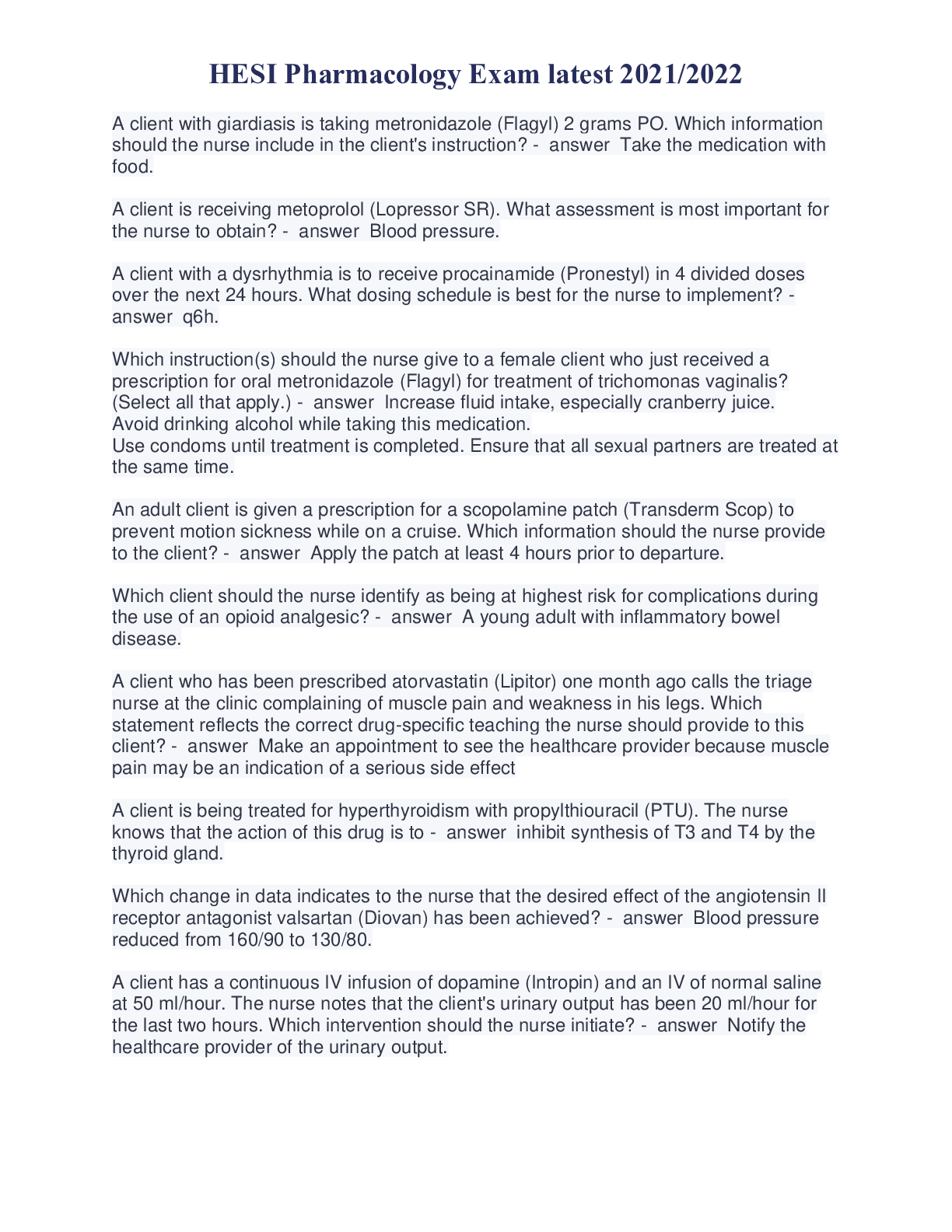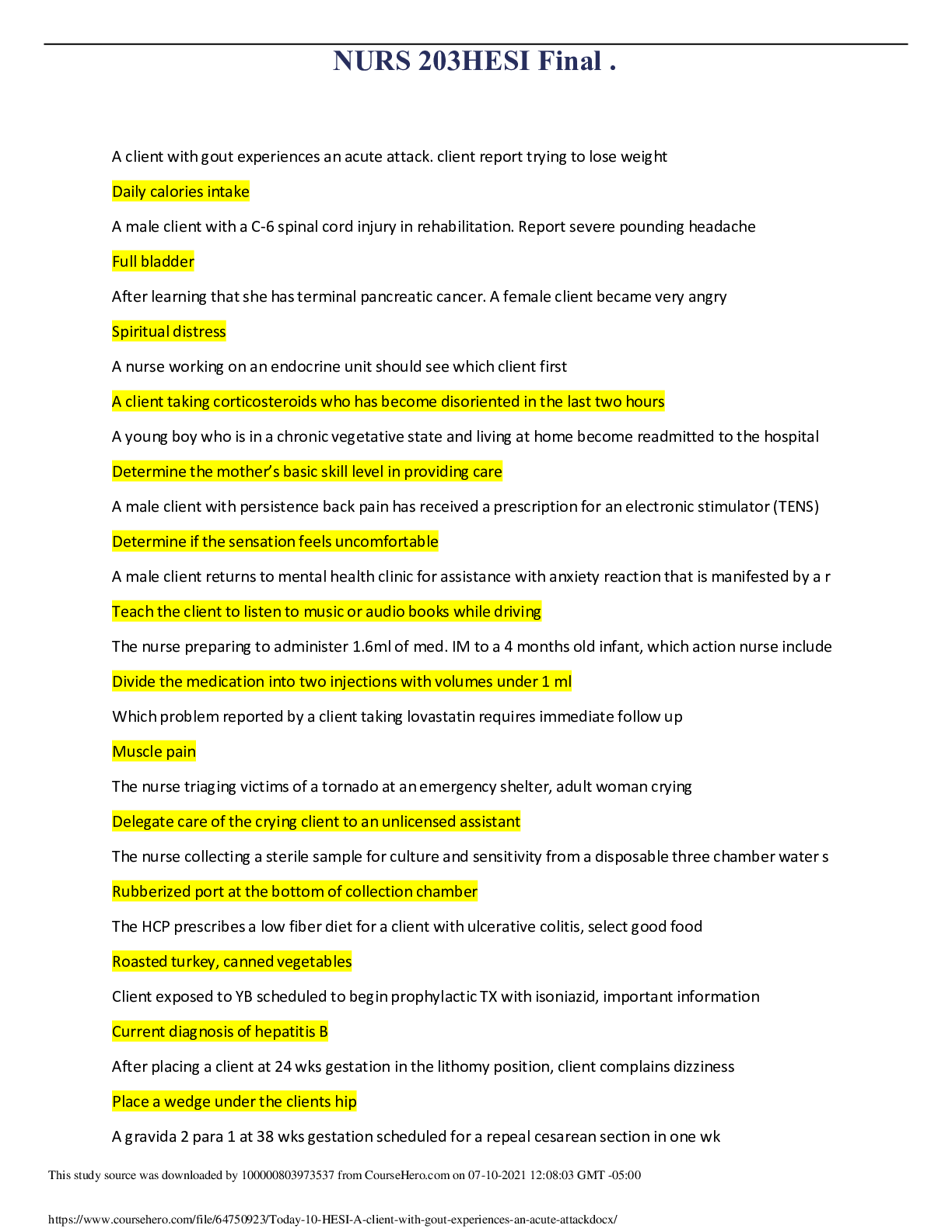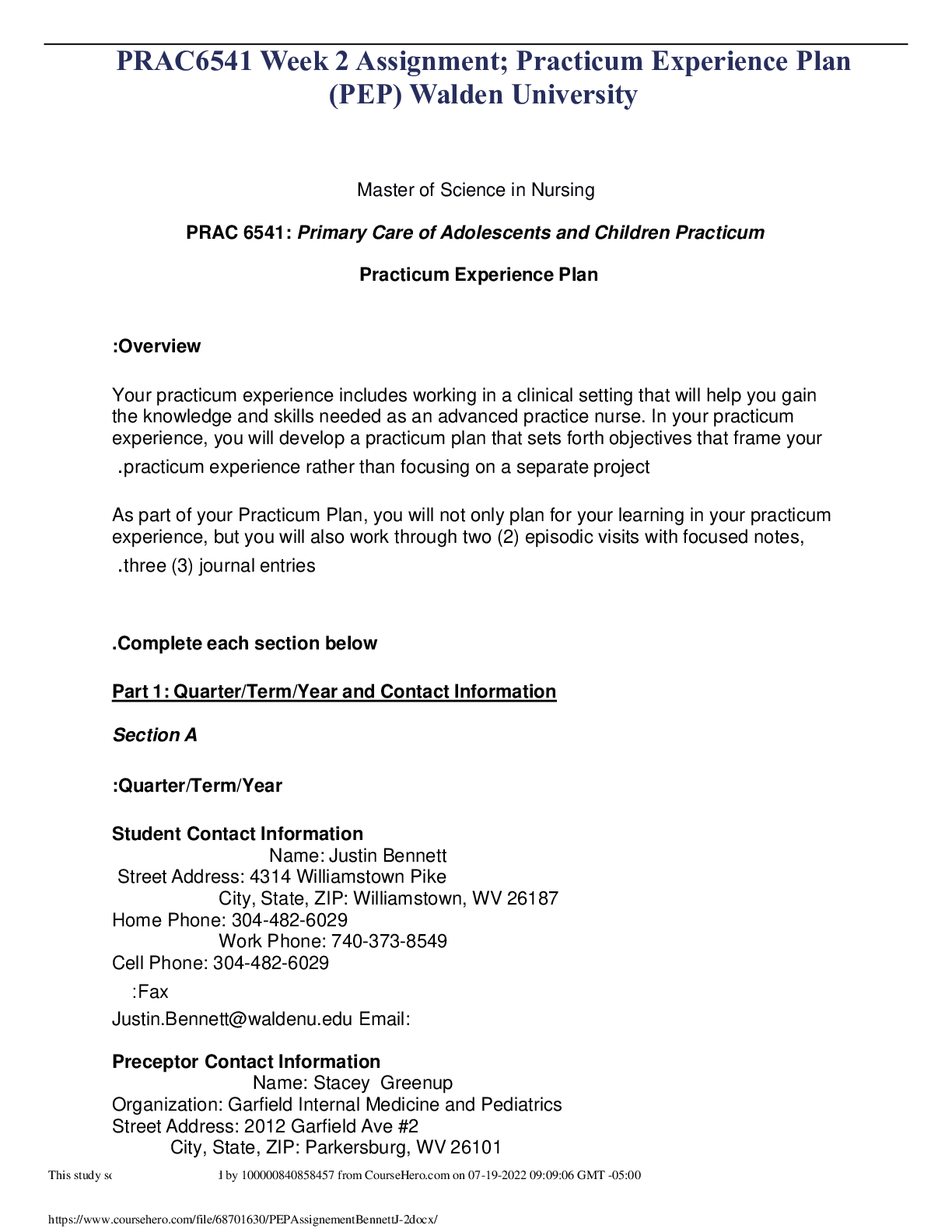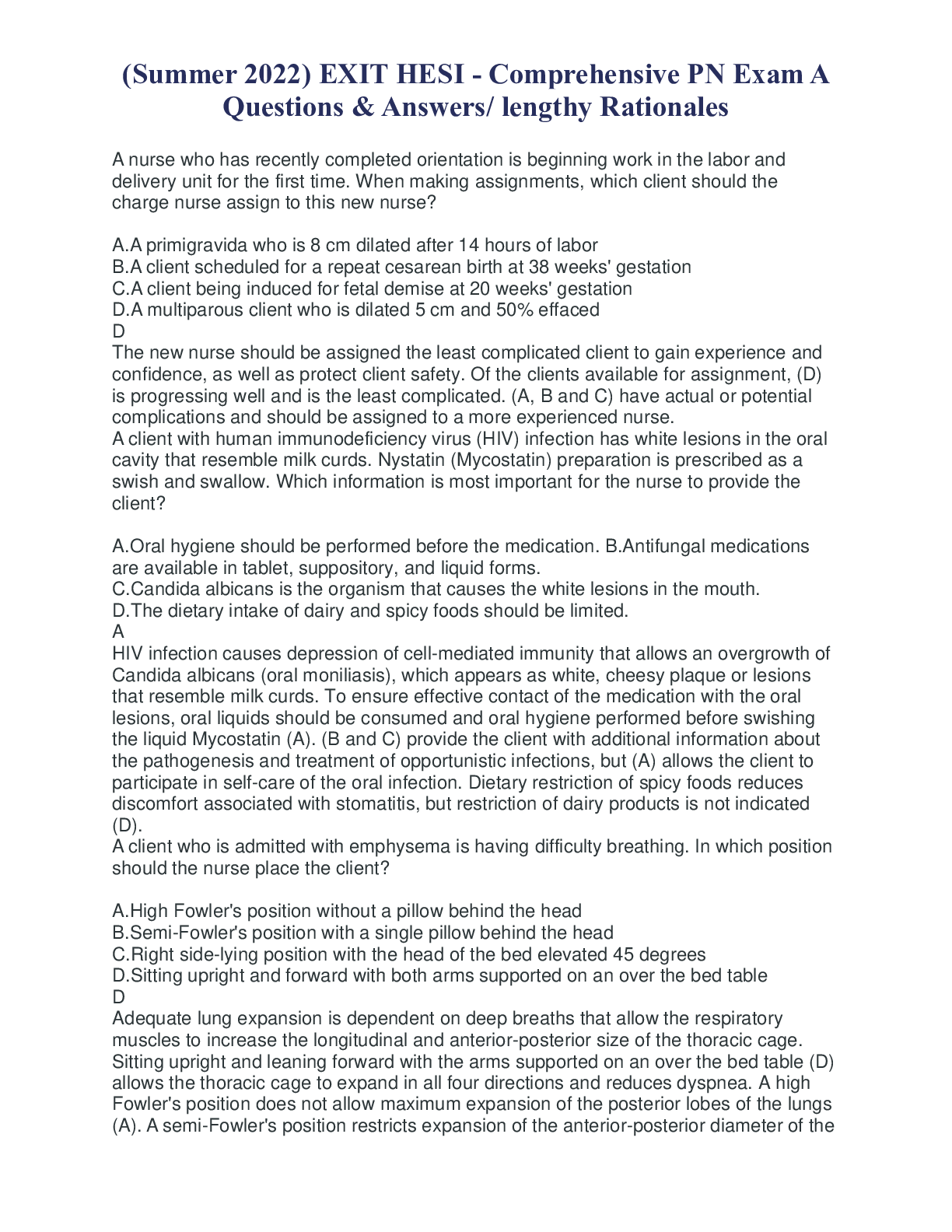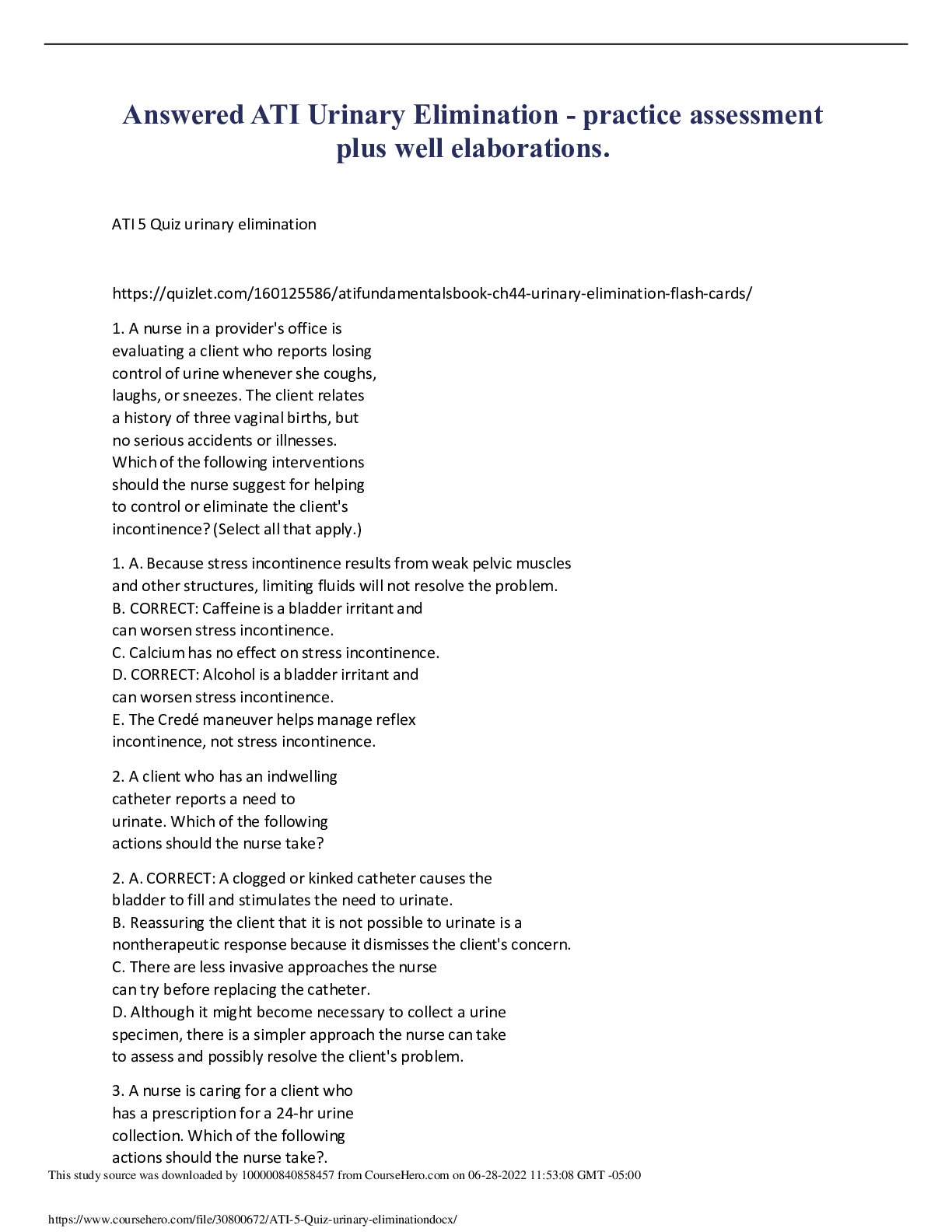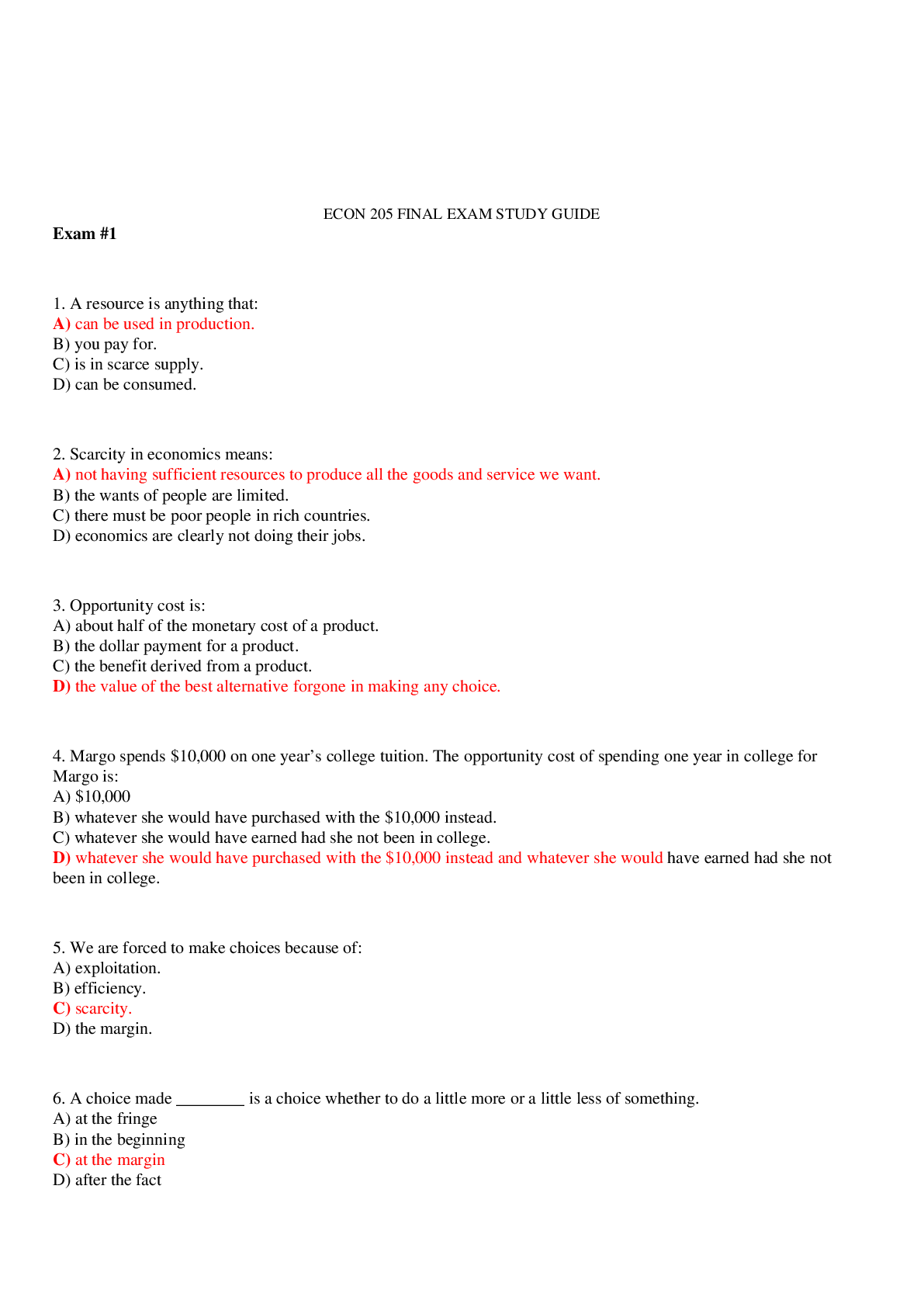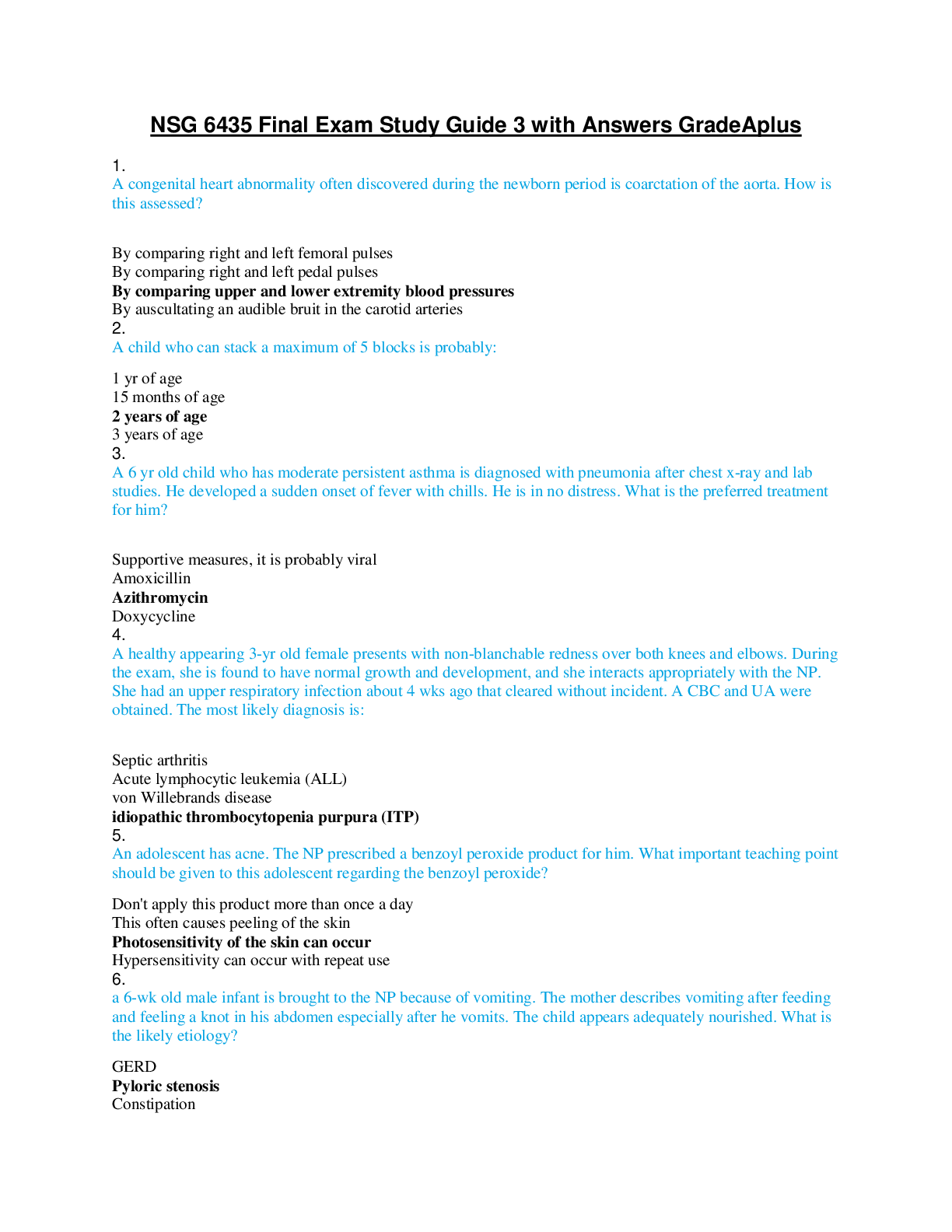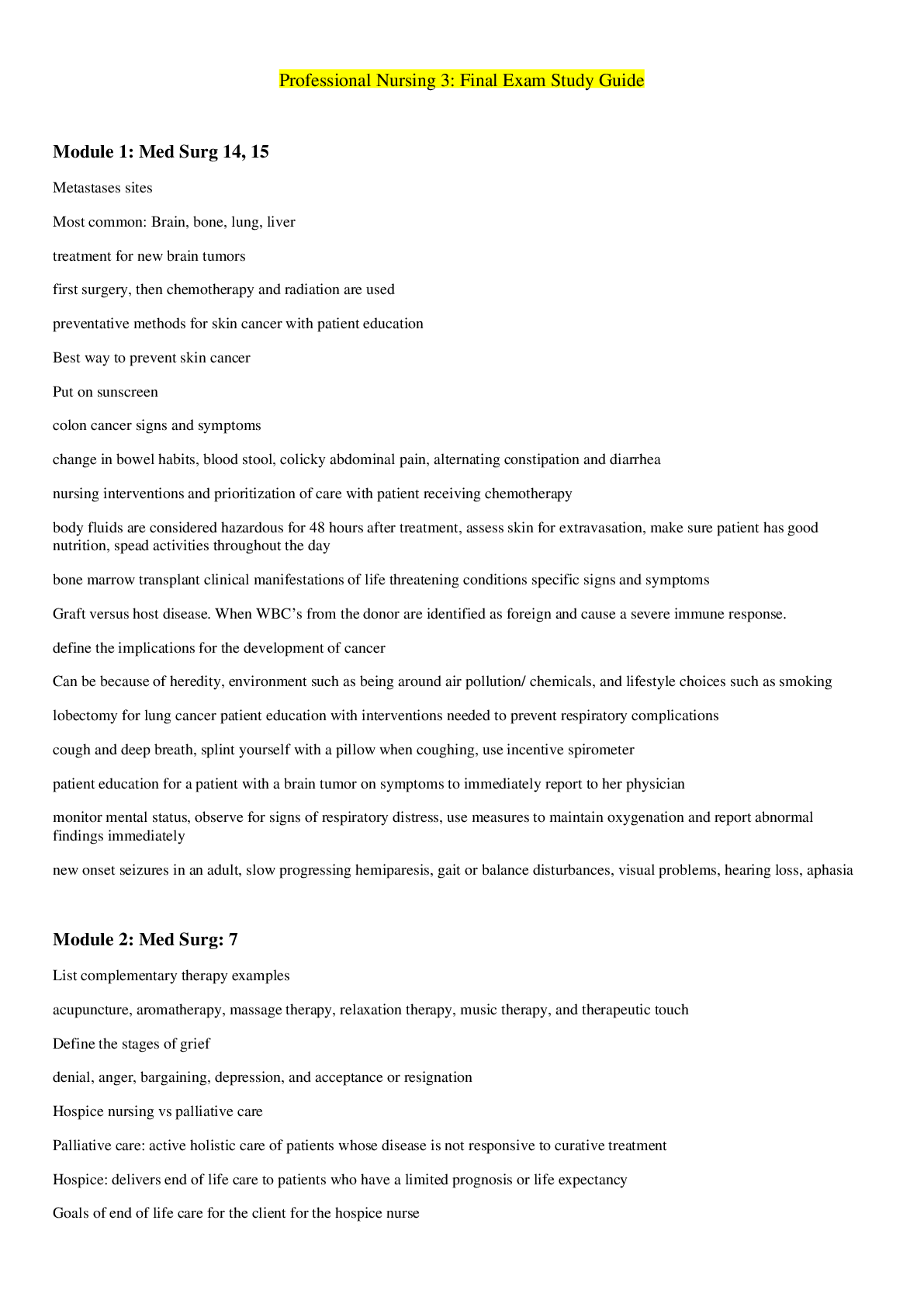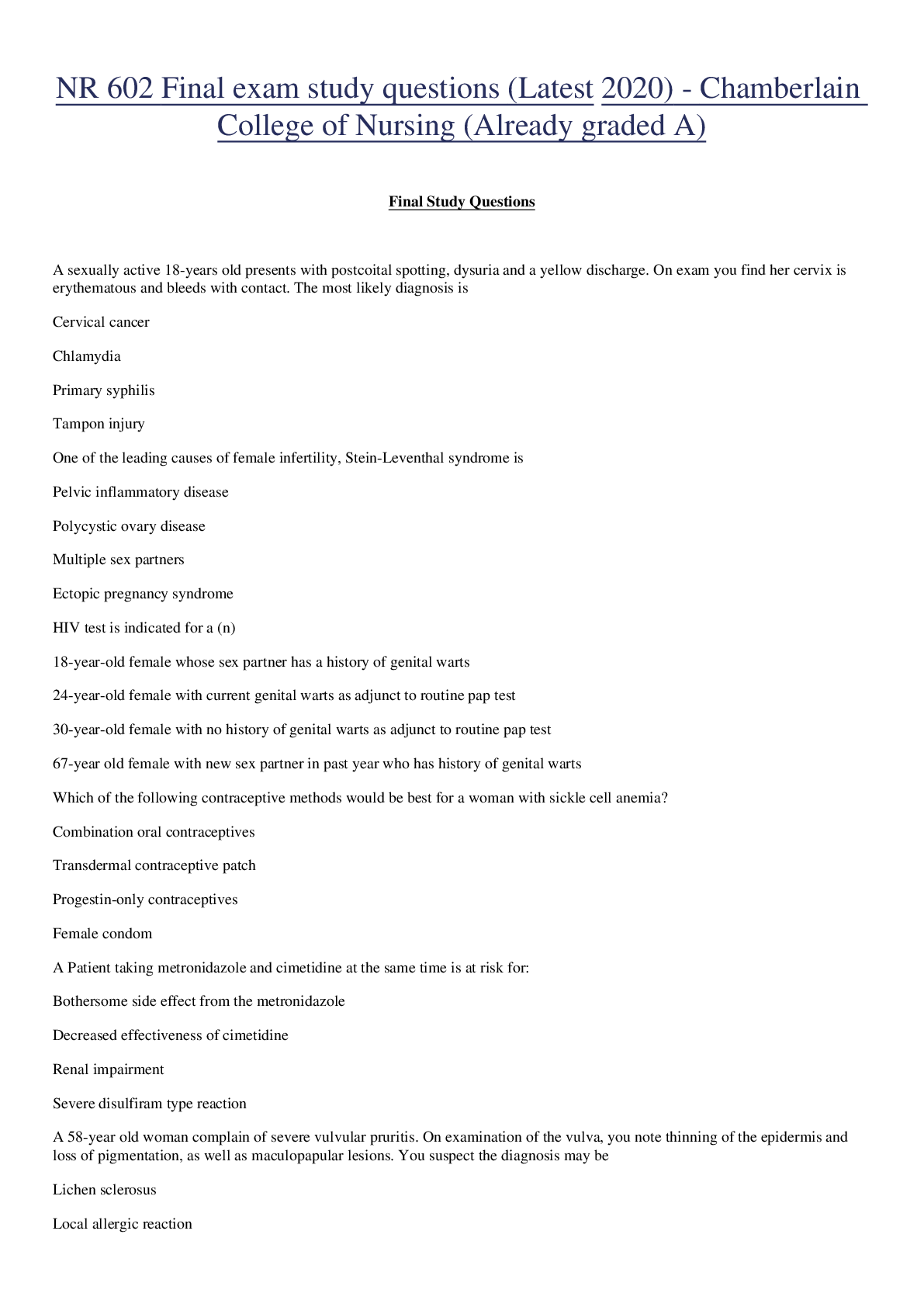NR 228 Final Exam Study Guide Chapter 1 to 11,GRADED A.
Document Content and Description Below
CHAPTER 1 (2 left to answer) How many calories are provided by protein, carbohydrates, fat and alcohol? Protein/Carbs: 4 kcal/gram Fat: 9 kcal/gram Alcohol: 7 kcal/gram What does “nutrient dens... ity” mean? Nutrient density assigns the value to a food on the basis of a comparison of its nutrient content with the kcal the food contains. The more nutrients and the fewer kcal a food provides, the higher its nutrient density. Know the basics of the six categories of nutrients. The six categories of Nutrients; Carbohydrates, Proteins, Lipids (fats), Vitamins, Minerals, Water. (**Pages 9-10 on the book goes into a lot of detail about each one***) CHAPTER 2 (1 left to answer) What are the five food groups of MyPlate? Veggies: 2 ½ cups Fruits: 2 cups Grains: 6 oz. Protein: 5 ½ oz. Dairy: 3 cups What is “fortification”? Enrichment of nutrients What nutrients are required on a food label? Calories, calories from fat, total fat, saturated fat, trans fat, cholesterol, sodium, total carbohydrates, dietary fiber, sugars, protein, Vitamin A, Vitamin C, Calcium & Iron Know how to read a food label (Page 30-32, page 32 shows an actual label**) The Daily Values is a system for food labeling composed of two sets of reference values: daily intakes (RDIs) and daily reference values. The percent of Daily Values information (%DV), based on a 2000 kcal diet, is intended to show consumers how much of a day’s ideal intake of a particular nutrient they are eating. DVs for selected nutrients and food components based on a 2500-calorie diet are also given at the bottom of the label. CHAPTER 3 In what order does food pass through the G.I. tract? The mouth the esophagus the stomach small intestine large intestine Know chemical versus mechanical digestion. Mechanical Digestion: Chewing, peristalsis, segmentation, action of sphincter muscles Chemical Digestion: Actual breakdown of substances from the production and/or storage of gastric and digestive secretions. Know the physiological function of the stomach, small intestine, pancreas, liver, gallbladder, and large intestine as it relates to digestion. Stomach: Holding food for partial digestion, producing gastric juice, providing muscular action, secreting the intrinsic factor for Vitamin b12, releasing gastrin, and assisting in the destruction. Small Intestine: Absorption of nutrients. Duodenum jejunum ileum Pancreas: Releases digestive enzymes. Liver: Releases glycogen. Breaks down RBCs. Breaks down fats and produces energy/bile. Gallbladder: Stores bile Large Intestine: Absorption of water. Consists of cecum, colon and rectum. CHAPTER 4 (1 left to answer) What are the three sizes of carbohydrates? Name examples of each size. Carbohydrates are classified according to the number of saccharide units making up their structure. • Monosaccharides: simple carbohydrates (glucose-corn syrup, fructose-fruits, galactose-found in milk) • Disacchardies: simple carbohydrates (sucrose-table sugar, lactose-milk sugar, maltose-malt sugar) • Polysaccharides: complex carbohydrates(starches-grains, legumes, and root vegetables, Fiber-whole grains, fruits, and veggies!) What is the normal blood glucose range? 70-100 What is the function of insulin? Bring down blood sugar. What are the health benefits of a high fiber diet? Prevents obesity, formation of diverticula, prevents cancer, prevents heart disease CHAPTER 5 (2 left to answer) What foods contain cholesterol? The only food sources of cholesterol are animal and include beef, pork (bacon), chicken, luncheon meats, eggs, fish, and dairy products (milk, butter, and cheese); plant foods do NOT contain cholesterol! What are good sources of omega-3 fatty acids? Linolenic Acid. Omega 3s may reduce risk by reducing clotting process. Fish sources for Omega 3: Salmon, mackeral, herring, tuna, trout, sardines. Plant Sources: Canola oil, walnuts/walnut oil, Soybean/soybean oil, flaxseed ground and oil, wheat germ and oat germ, green leafy veggies Which lipoprotein in high levels correlates with low cardiovascular risk? HDL Which lipoprotein in high levels correlates with a high risk of heart disease? LDL Be able to interpret serum cholesterol lab tests (Page 366) HDL Levels: Normal is 35-65 mg/dL for men and 35 to 80 for women. (40 or higher is good!) LDL Levels: less than 100, a reading of 130-159 is borderline high and 160 189 is high What is the difference between a monounsaturated fat, a polyunsaturated fat, and a saturated fat? What are sources of each? Monounsaturated Fatty Acid: Only one unsaturated double bond. Ex Oleic Acid, Olive oil, peanuts, canola oil, peanut butter, peanut oil and avocado. Saturated Fatty Acid: single bonded carbon chain. Ex: Palmitic Acid found in animal-derived foods Food Sources: beef, poultry, pork, lamb, luncheon meats, egg yolks, and dairy products. Palm and coconut oils. Polyunsaturated Fat: Two or more unsaturated double bond. Ex: veggie oils, fish, margarine. CHAPTER 6 What are the major functions of proteins? Provide energy and structure to body. What kinds of food are quality sources of protein? Found in animal and plant sources meat, fish, poultry, and some dairy products, such as milk and cheese. Grains, legumes, peas and beans, seeds, nuts and many veggies. CHAPTER 7 Name the water-soluble vitamins. Vitamin C & B Name the fat-soluble vitamins. A,D,E,K. What are good sources of Vitamin C? Green leafy veggies, bacteria in GI tract, eggs, and carrots What is a sign of Vitamin C deficiency? Scurvy w/ bleeding What is the main function of the B vitamins? Metabolism What are good sources of Vitamin B-12? Animal Products What is the main function of Vitamin D? Necessary for absorption of calcium & phosphorus; affects bone mineralization What is the main function of Vitamin K? Blood clotting CHAPTER 8 What minerals are lost through sweating and bleeding? Zinc, Magnesium, sodium, potassium, and calcium What are the two categories of minerals? Trace & Major Which minerals are in each category? TRACE: Chromium, Copper, Fluoride, Iodine, Iron, Manganese. MAJOR: Caclium, Phosphorus, Magnesium, Sulfur What is the definition of each category? Trace: RDA < 20 mg Major: RDA at least 100 mg a day Name the differences between intracellular, interstitial, and extracellular fluids. Intracellular fluids- in cells Interstitial fluids- in between cells Extracellular fluids- outside of cells What enhances iron absorption? Vitamin C What reduces iron absorption? Milk, phylates, oxylates, teas and coffee CHAPTER 9 (4 left to answer) What is basal metabolic rate? Rate at which the body spends energy to keep all life-sustaining processes going. What percent of daily expenditure is used for basal metabolism? The basal metabolic rate accounts for about 60-75% (Honestly found this one on google ) What factors affect basal metabolic rate? What are the BMI categories? Underweight: Less than 18.5 Normal Weight: 18.5-24.9 Overweight: 25-29.9 Obese: Higher than 30 How do you calculate BMI? Divide your weight in kilograms (kg) by your height in metres (m) then divide the answer by your height again to get your BMI What nutrients yield energy when metabolized? Carbs, protein, and fat CHAPTER 10 (3 left to answer) Ideally, how much weight should a normal woman gain during pregnancy? 25- 35 lbs What nutrients need to be increased during pregnancy? All EXCEPT D,E,K, Phosphorus, fluoride, calcium. What advantages does breastfeeding have over bottle-feeding? Antibodies from mom What nutrient may need to be supplemented in breast-fed infants? Iron, Vitamin D, Fluoride At what age should you introduce solid foods to an infant? 4-6 months What are the recommendations for fruit juice in infancy? Around 6 months 4-6 oz a day until 12 months Main nutrition concerns of childhood? Obesity, Type 2 Diabetes pages 213-215 in book), Lead poisoning because they naturally absorb greater amounts of minerals than adults, iron deficiency Main nutrition concerns of infancy? Food asphyxiation for toddlers, avoid peanuts, popcorn, hard candies, grapes, and foods containing bones. Main nutrition concerns of adolescence? Obesity CHAPTER 11 Types of malnutrition? Starvation-Related Malnutrition: Chronic starvation without inflammation Chronic Disease-Related Malnutrition: Chronic Inflammation of mild to moderate degree. Acute Disease-Or injury-Related Malnutrition: Acute inflammation of severe degree Requirement for hospital nutrition screening? Must be done within 48 hours. What are anthropometric measurements? ABCD Anthropometric, biochemical, clinical and dietary assessment Anthropometric: Simple, noninvasive techniques to measure height, weight, head circumference, and skinfold thickness. Biochemical: No single test for nutrition. Important indicators visceral protein status and immune function. Serum albumin; prealbumin; lymphocyte count. BMI. Clinical Assessment: Medical history, physical exam, features associated with deficiencies. Dietary Assessment: 24 hour recall, food diary [Show More]
Last updated: 2 years ago
Preview 1 out of 6 pages

Buy this document to get the full access instantly
Instant Download Access after purchase
Buy NowInstant download
We Accept:

Reviews( 0 )
$25.00
Can't find what you want? Try our AI powered Search
Document information
Connected school, study & course
About the document
Uploaded On
Apr 29, 2021
Number of pages
6
Written in
Additional information
This document has been written for:
Uploaded
Apr 29, 2021
Downloads
0
Views
71





